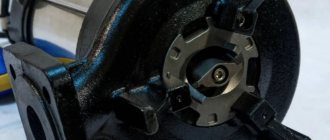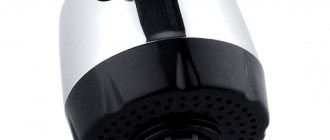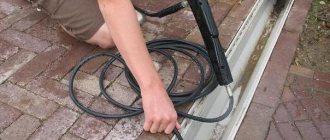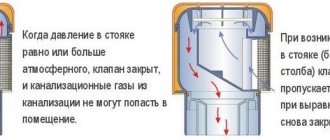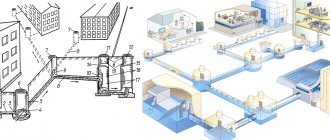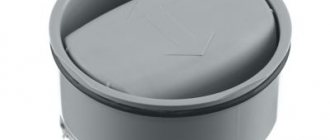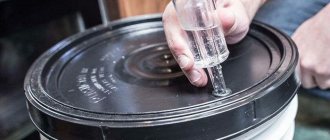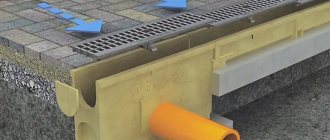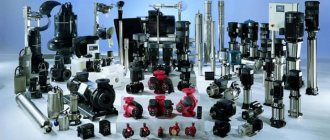A water seal is a curved pipe or other structure that holds a certain amount of water inside. The device prevents the penetration of odors from the sewer and ensures the movement of wastewater
Sewerage is far from being a bottle of perfume; its composition is such that it emits extremely unpleasant, sharp and persistent odors. To protect against unpleasant odors, they came up with a sewerage device called a water seal.
This simple device reliably cuts off the internal space of the drain from the living space, saving the inhabitants of the house from unpleasant contact.
General information
Sewage in the house can be a source of unpleasant odor, which is always present in it due to the activity of bacteria. If you directly connect sinks and other similar equipment to the sewage drainage system without installing siphons, the aroma from the pipelines will appear in the house.
The hydraulic valve is an important element of the intra-house sewerage system. It has a simple design, but allows you to prevent the appearance of unpleasant odors from sewage pipes in the room. After all, a water plug forms in it, which prevents the penetration of odors.
The part of the siphon where the water is located is always located below the drain hole. Therefore, liquid is retained in the device when water is not drawn. The part of the siphon with water has a curved shape. This design prevents the complete removal of liquid from the device.
When draining occurs, old water that is trapped in the curved part is displaced. This process cleans the device and prevents microscopic organisms from growing.
The principle of operation of a hydraulic valve using the example of a toilet bowl Source kupisantehniky.ru
A water seal is a sewerage element that also prevents water hammer. Due to their blocking, excessive load is not created on the pipes and the entire system as a whole.
With correctly selected water seals, the period of proper operation of the sewer network increases. Therefore, the level of comfort in the house does not decrease.
When the installed siphon is not used for a long time, the liquid evaporates, which is retained in its curved part. For this reason, after a certain time, an unpleasant aroma from the sewer will appear in the room. The smell will also be felt during the first flush after a long period of not using the plumbing equipment.
On a note! If an unpleasant odor appears from the sewer network, it is necessary to check the presence of water in the curved part of the siphon. It can disappear not only as a result of evaporation, but also due to leakage if the device bursts. The problem is solved by installing a new element.
Installing a new hydrosiphon Source multiscreensite.com
Installation of water seal on sewerage
The siphon devices produced today are so clear and simple that installing them in place in the system is extremely simple and anyone can do it themselves. Let's look at a few examples:
- A self-formed water seal device can be made from a piece of pipe and several standard fittings.
The use of additional sealing in the form of sealant will ensure long-term operation of the device.
- In the same way, a drain connection is formed in a shower or bathroom, and it can be connected directly to a collector pipe with a diameter of 110 mm.
If cleaning is necessary, the device is simply dismantled and then put back together.
Considered the most difficult to install, a bathtub water seal can easily be made using a corrugated plastic hose. The corrugation is used for the overflow device, which is also a mandatory element of the plumbing piping of the bathtub, and the siphon can be used either as a single piece, selected according to size, or from the same hose. The inconvenience of working in cramped spaces forces us to pay special attention to the quality of installation of fasteners - without distortions and strictly according to the thread.
- The easiest way is to connect a bottle water seal to the kitchen sink.
To do this, you need to install the upper funnel into the hole in the sink and tighten the clamping nut. Before this, a gasket is installed under the funnel. Do not over-tighten the nut; it may dislodge the gasket from its conical seat and cause a leak.
After this, the casing is put on the pipe and secured with a nut. The corrugated pipe is led from the body to the inlet rubber bushing at the opening of the sewer pipe. The sleeve is selected to match the outer size of the hole, and the inner size to match the diameter of the corrugated pipe tip.
Just in case, it is better to treat the seats with silicone sealant. To complete this connection it will take about 15 minutes.
Watch the video
Braga. Part 3. Connecting the water seal to the sewer
How to make water seals with your own hands
The need for a siphon in the sewerage system is absolutely obvious. How to make this simple but important detail with your own hands? To do this, it is best to use standard fittings of the required size. Of course, you need to have the skills to solder plastic pipes using special equipment - a soldering iron.
Watch the video
Causes of sewer smell in the bathroom and kitchen + how to make a vacuum valve
But this is a simple art and learning it is not difficult and does not take long. The device can be rented on a daily basis without spending any money on purchase.
Types of sewer valves
You need to have a good understanding of how a water seal for sewerage works and what it is. It is also necessary to know all its main types in order to accurately select a device for specific plumbing equipment. The classification of a mandatory sewerage element is influenced by its design features. There are 6 main types of devices that artificially create a column of water, the height of which is usually at least 100 mm.
Knee model
The knee-shaped hydraulic valve cannot be confused with other similar devices. It looks like the letter U. This type of siphon is durable. It maintains its integrity even if high pressure occurs in the pipes.
The throughput of the knee model is affected by its cross-section. This parameter can never be less than the diameter of the outlet of the connected plumbing equipment.
The knee version is installed when installing toilets, bathtubs, etc. Depending on the design features of the plumbing equipment, two siphons can be connected at once.
Elbow-shaped hydrosiphon for bathtub Source cloudinary.com
On a note! Previously, the water seal for sewerage was made of cast iron. Today, most models are made from polypropylene. This is a durable lightweight material. There are also metal knee and other types of siphons with a chrome surface, which do not spoil the interior if they are installed in an open way - they are not covered with furniture or plumbing equipment.
Manufacturers produce non-separable and collapsible knee valves. The first option does not allow adjustment, and when it fails, it is completely dismantled. Collapsible models allow you to change their size and configuration. You can regulate the amount of water that accumulates in them. To fix the selected position of individual parts, the design of dismountable devices includes plastic nuts and overhead clamps.
The knee part of the water seal has two bends. One of them is at the inlet, and the other is before the outlet of the liquid. It is located approximately 50 mm higher than the first bend.
On a note! A more reliable water plug is created in an S-shaped device. Its principle of operation does not differ from the standard modification.
S-shaped pipe siphon Source mcalpineplumbing.com
Cleaning of elbow options is carried out after their complete dismantling. A flexible cable is also used for this purpose.
Manufacturers produce knee models with an additional inlet, to which a hose from a washing machine or dishwasher is connected. Such options are often installed in the kitchen.
See also: Catalog of companies that specialize in engineering systems (heating, water supply, sewerage and others) and related work
Bottle model
This type of hydraulic valve is used in the kitchens of private homes. The device is installed to organize the drainage of sinks. Such a siphon is capable of trapping food waste that enters the sewer network when washing dishes. Therefore, the pipes of the sewage disposal system do not become clogged, which does not lead to a decrease in their throughput. In addition, the model effectively prevents the penetration of foul odors into the room.
Bottle chrome-plated hydrosiphon Source pandashop.md
A hydrosiphon consists of more than just pipes. The device also has a bottle-shaped container. This is where food debris accumulates. This container is located below the sewer inlet into which the last horizontal pipe element of the siphon is inserted. It is not difficult to get to the so-called sump tank if it becomes clogged with food waste. It is cleaned after unscrewing the cover nut.
Important! The bottle water seal is a collapsible design. Each part can be quickly detached for cleaning or changing the configuration of the product.
This type of plumbing sewer element is also made of polypropylene. However, it is inferior in strength to knee models. The reason for this is the presence of several threaded connections that may not withstand the strong pressure of wastewater. Because of this, bottle models are installed only in kitchen areas. They are not used in the bathroom.
Polypropylene siphon with bottle container Source price.ru
A bottled hydrosiphon also allows you to avoid losing an item irretrievably if it is accidentally flushed down the drain. It will linger in the sump. There have been cases when housewives have had jewelry slip off their fingers while washing dishes. They were quickly removed from the siphon.
Double turn model
This type of hydrosiphon resembles a knee valve, but it has a more complex design. Thus, a 50 mm double-turn water seal for sewerage is equipped with a grate. It is located at the junction of the drain pipe, for example from the sink, and the main part of the device, which traps stench from the sewer. The presence of a mesh filter allows you to catch hair and various debris.
Double-turn polypropylene siphon Source myjoys.ru
After the grate, the straight drain pipe takes the shape of an elbow. Another pipe part is connected to it. It is inserted into the sewer system, can be turned horizontally in any direction and is located at a slight slope.
The double-turn model is more difficult to maintain than the bottle version, but is more reliable. It leaks less often. The double-turn device is an adjustable siphon that is suitable for installation even in confined spaces.
Choosing a water seal for sewerage
The modern construction market offers a wide range of siphons, which may differ according to various criteria:
- According to the material of manufacture.
- Traditionally, water seals were made from cast iron. The material is very durable and strong, not exposed to aggressive environments. The disadvantage of such siphons is the rough inner surface, which tends to retain various types of pollution, and especially fatty inclusions.
A siphon made of cast iron must be equipped with an inspection window so that the sewer can be cleaned without its complete installation.
Hydraulic valves in this design are currently still used in industrial construction.
1.2.
The most popular water seals are made of plastic, which is facilitated by the relatively low price of these products. Not the least role is played by their high consumer qualities - smooth inner surface, chemical inertness. In addition, siphons made from plastic pipes are technologically advanced - they are easy to assemble and adjust to their location. Do-it-yourself water seals for sewerage are most often made from this material.
You need to pay attention to the plastic water seal made of corrugated pipe. When installed, they can be given almost any shape and bending direction, which allows them to be used in cramped locations.
1.3.
Metal products made of bronze or brass, electrochemically coated with a layer of nickel, are popular. This is done not only for decorative purposes, but also allows you to extend the life of the reinforcement, preserving the surface from oxidation.
Installation of such plumbing fixtures must be carried out with extreme caution, using a tool with plastic jaws to avoid scratches on the mirror surface of the products.
1.4. Water seals and other stainless steel plumbing fittings can be considered special-purpose products. They are used in children's and medical institutions, in public catering establishments. This is done to use the basic properties of the material - it is easily washed and easily disinfected.
- For special qualities.
2.1. If you are selecting a water seal for a kitchen sink, you need to opt for a bottle design. This device allows you to quickly remove the outer storage container and clean its interior from food debris from the kitchen sink, or even retrieve a gold ring that has slipped off a wet finger.
2.2. When choosing a drain for a shower, kitchen or bathroom, you should take into account the frequency of use of these rooms. If they do not work for a long time, the water seal dries out with predictable consequences. Therefore, for a summer residence, all drains must be additionally equipped with dry seals.
2.3. When connecting bathtubs to the sewer system, it is most convenient to use a water seal made from a corrugated hose, given its ability to be placed in the tightest places.
When choosing a water seal for sewerage, you should take into account not only the features of the installation site, but also take advantage of the advantages provided by the design and other features of the devices.
Watch the video
Draining water in a bathhouse with a water seal system.
Shutter selection criteria
Homeowners should definitely know how a water seal works. This will allow you not only to select the right device for plumbing equipment, but also to operate it correctly and even control the installation process, which will be performed by hired craftsmen from a specialized company.
When selecting a siphon, take into account:
- dimensions of the shutter in assembled state;
- device type;
- material of manufacture;
- number of drains and overflows;
- the presence of a filter grid;
- cross-section of inlet and outlet;
- the presence of additional elements in the design.
For example, if you install a bottle seal in the kitchen, then leftover food and other debris will be retained in it. When choosing a knee siphon, food particles will go down the drain. This can lead to a clog in a hard-to-reach area.
On a note! It is recommended to first measure the free space under the plumbing equipment so that you can install the valve without any problems.
Tips and tricks for use
For sinks, do not use a corrugated siphon, despite the fact that these pipes are flexible and compactly laid. The downside is that debris is deposited in the bends of the corrugation, and the diameter of the pipe decreases. It is advisable to use it for a bath.
It is undesirable to expose the water seal to boiling water or hot oil - this will lead to cracks in the pipe and, as a result, leakage.
For rarely used plumbing fixtures, only dry water seals are required. If there is a cold effect on the sewer, you should not use a combined float design. Modern siphons are made of polymer materials, they do not rot, are easy to install, and serve for a long time. Metal products are chrome plated to resist corrosion.
The reason for the appearance of an odor in a room with properly installed hydraulic equipment can be depressurization of drain pipes, a long-term operated sewer system in which bacteria multiply on the vessel wall, or a broken water plug. To check the tightness of the equipment, you need to bring a lit candle to the opening of the sink or toilet. If the flame does not fluctuate, there is no depressurization and it is enough to pour a disinfectant into the sewer.
Plug failure occurs if the diameter of the sewer pipes is small and the volume of drained water is significant. A pressure difference is created in the pipes and the liquid moves in the opposite direction. In this case, it is enough to open the tap for 2-3 minutes so that the water restores the seal in the siphon. This will solve the odor problem.
Briefly about the main thing
A dry or hydraulic seal is one of the elements of an in-house sewage disposal system that prevents the appearance of unpleasant odors from sewer pipes in the room. Typically, the device retains water, which prevents the smell from entering the room from the waste pipes. The dry version is equipped with a membrane, float or pendulum that blocks the sewer hole.
Manufacturers produce elbow, bottle, corrugated, double-turn hydraulic siphons and models with overflow. Depending on their design, they are installed under sinks and bathtubs. A specific model is selected taking into account the size, type, number of drains, and the material used for manufacturing - metal or plastic.
Ratings 0
How to choose
Siphons are selected to provide water seals according to the material and for specific plumbing fixtures. The most common option is plastic. They are easy to install and are sold at a low price. Siphons made of chromed metals and cast iron are also used, but the conditions for their installation and maintenance are more complicated than those of plastic ones.
You should consider which plumbing fixture will protect the water seal. It is best to pass drainage from the kitchen sink through a bottle-type device - this is where drain pipes become clogged more often, and it is easier to remove dirt with this type of siphon. Sinks are equipped with overflow protection, so a knee valve is suitable for them.
It is more profitable to choose products made of polypropylene or chrome-plated metal.
If you plan to use two sinks in parallel, then you need to install a device with two drains with one siphon.
The selection of a drain valve for a bathtub depends on the height at which the bowl is located above the floor. The siphon is chosen so that it fits in this space. Bent and corrugated valves work well in bathrooms. Protective devices are chosen in a similar way for other plumbing fixtures and for the bathhouse.
If there is a danger of the valve breaking, it is better to ensure its operation by installing a vacuum valve.
Reasons for failure
The water seal of the sewerage system is a structurally simple product that does not contain complex elements, so its failure occurs quite rarely. The following situations arise most often:
- A water seal failure in a sewer occurs when the pipe in an apartment in a multi-storey building, a cottage, or in a country house along the riser above is closed or clogged. In this case, when large volumes of water are drained, the vacuum formed in the riser pipe carries water from the water seal with it, and it opens. This problem can be eliminated by cleaning the riser pipe or installing a vacuum valve at its end.
- Blockages are the most common cause of failure of water seals; dry operating devices are especially susceptible to this disease. If debris gets under the lowering float or into the closing sleeve of the membrane, they cannot close and foreign odors enter the room.
- Improper installation is another reason why water seals malfunction. Failure to observe slopes in pipes, spontaneous straightening of corrugations, and violation of the assembly sequence of complex systems leads to incorrect operation of locking devices.
- Leaks can also cause water seals to fail. A situation that often arises is that water flows out of the bottle elbow through a poorly screwed sump lid at the bottom.
Rice. 11 Types and cost of siphons for sinks and bathtubs
Main stages of installation
To install a dry siphon yourself, you should carefully study the steps of its installation. If certain conditions are met and everything is done correctly, then the installation of this structure will not cause problems. The most common problem after installing a water seal yourself is leaks. If you don’t have confidence in your own abilities, you should seek help from a specialist who can carry out this task easily and efficiently.
Installation of this device is quite easy. Here are the main steps:
- First you need to check the device. Gaskets and seals must be in place exactly.
- During the second stage, a rubber sealing ring is placed between the siphon and the sink. This ring is necessary to seal the joint.
- A siphon is installed, and a sealant is applied to the joints, making the seams more reliable and reducing the chance of the structure leaking.
Dry sewer siphons are fairly reliable structures and do not require frequent checks and are quite resistant to blockages. To select and install this device, you must follow the recommendations and rules given in this article. You need to choose this device carefully and carefully, and in this case the result will not be long in coming; the device will work reliably for many years.
Factory designs
If you don’t want to make a water seal yourself, you can always purchase it in specialized stores. They are inexpensive, but at the same time they work flawlessly and look aesthetically pleasing. As a rule, they are presented in two options:
- Double-chamber is a curved tube with two chambers that are connected in series to each other. Water is poured inside, and the upper part is sealed using a special plug. The design is made of durable food-grade plastic.
- Collapsible or three-chamber, which is a collapsible glass into three sections. The main glass is filled with water, into which gases enter through a tube. The advantage of this model is the ability to thoroughly wash all parts, which increases the service life.
Regardless of the chosen design of the water seal, it is necessary to check the tightness before installing it on the suley. If it is noticeable that the contents are actively fermenting, and bubbles do not appear in the water seal, then you need to check the quality of the insulation of all connections as quickly as possible.
Some non-standard options
When listing the following methods, the saying involuntarily comes to mind that “the need for invention is cunning.” What exceptionally inventive master winemakers will go to!
- use a regular valve with a ball from a vodka bottle;
- adapt nipples from bicycle inner tubes complete with soft thin capillary hoses;
- put an inflatable children's balloon on a bottle of wort and poke a hole in it;
- Insert cocktail tubes and juice straws into the hole in the lid.
To make the connections airtight, you can drip them with wax, paraffin, use pieces of plasticine or
Whatever water seal is used in the distillation of homemade drinks, you need to remember the importance of a tightly fitting lid, the gas pressure in the container with fermenting wort, and the aging time of the finished wine.
Characteristic features of the overflow system
Another type of product is a hydraulic siphon with a water seal for a sink or sink, equipped with an overflow system. The device is equipped with an additional pipe, which eliminates the possibility of flooding of the apartment if it is impossible for water to drain into the sewer. This pipe is inserted into a hole specially created for it, which is located in the upper part of the sink or sink.
This siphon prevents flooding, but increases water consumption. If the tap is turned on and the drain is closed, water will flow through the overflow pipe into the sewer when it reaches a certain level. A water seal with an overflow system can be installed in the kitchen or bathroom.
Hydraulic valves with an overflow system are made of plastic or metal. Plastic products have a lower cost and are very flexible. Brass-bronze siphons are characterized by strength, durability, complexity of installation and high cost.
Important! When choosing a siphon with an overflow, you should pay attention to the throughput of the pipe so that the device will work efficiently in the future.
The water seal for a sink or sink is equipped with an overflow system - an additional pipe, thanks to which the possibility of flooding of the apartment is eliminated
